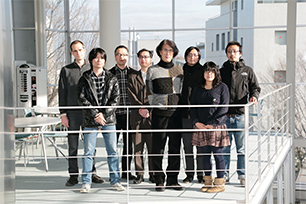Toru Iwatake, Professor, Faculty of Environment and Information Studies
Exploring the music of the 21st century
From the site of music creation

The theme of my seminar class is the creation and research of multimedia artwork involving sound by applying information technologies. In this field, research is indispensable in order to create something, so in other words, when a new work is complete, so is your research paper. We mostly present these new works at international conferences held overseas. Modern artists are simultaneously researchers of expression, so the most successful people tend to have a Ph.D., but they have different backgrounds and come from diverse fields such as art, mathematics, engineering, biology, and others. There are also academic meetings, but because many of the attendees are creative people, the atmosphere is far from stuffy. For example, I used to joke around with Miller Puckette, a former classmate of mine who is known for authoring MAX/MSP and PureData.
So, I think that the spirit of hangaku-hankyo, or “learning while teaching, teaching while learning,” can always be seen quite naturally in my seminar class. Students give each other constructive feedback when presenting their work and ideas, so they all make considerable progress. Over time, they come up with interesting work, which we take to an international conference. Some students don’t show up much for class but instead show up in the club scene, where they seem to have acquired celebrity status.
The musical sounds we create seem to be similar to that of the so-called “subculture.” For example, a student from the U.S. who joined my seminar class to study Japanese subculture released his own computer music compositions from a minor label, which then rose to be a top-seller at the old HMV store in Shibuya, and his CD was displayed in the showcase of the store. Because of this, among many other achievements, he received a Ph.D. at SFC, and is now a successful artist and college professor back in his home country. The power of Japan’s subculture is quite surprising. At least in the field of music, there seems to be a hangaku-hankyo relationship between academia and subculture.
Student’s Voice
Shunsuke Hananoi, First-year student, Graduate School of Media and Governance
The best part of Professor Iwatake’s seminar class (CSP)
Professor Iwatake’s seminar class is separated into two groups: the undergraduate research group, which handles harmony and music composition, and the graduate school project called the Cyber Sound Project (CSP). The class is positioned as a “research lab on computer music,” but in reality, anything is OK if it relates to sound. If you have a firm view about the meaning and a reason for creating it, you can get all kinds of advice and opinions and move forward with your creation. Its focus on sound makes it specific even among the creative labs, but research is that much more challenging because of it. All the members of the class love music and sounds. If you feel the same way, I think this is the most appropriate place to find what you really want to do using sound.
*Position titles, etc., are those at the time of publishing.
